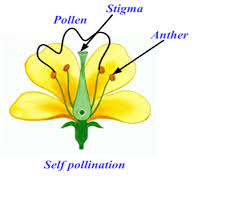SELF POLLINATION-MECHANISM & CONSEQUENCES
DEFINITION
When pollen from one flower pollinates the same flower or other flowers of the same plant, known as self-pollination. There are two types of self-pollination in flowering plants, defined here.
- Autogamy– Here pollen is transferred from anther to the stigma (female part) of the same flower.
- Geitonogamy– when pollen is transferred from anther to the stigma of another flower of the same plant.

MECHANISM PROMOTING SELF-POLLINATION
There are several mechanisms which promote or ensure self-pollination. Majority of the grain crops are self-pollinated.
Mechanisms, which facilitates self-pollination are as follows-
- Cleistogamy- Some flowers don’t open and thus ensure self-pollination, e.g. some varieties of wheat, barley, oat and some grasses.
- Chasmogamy- In this case, flowers opens but only after pollination. Thus, only some cross-pollination here may take place after opening of flowers.
- In some crops, stigma is closely surrounded by anthers and pollination usually occurs when the flowers open. Thus such mechanism also promotes self-pollination. Examples are tomato, brinjal etc.
- In some legumes, like pea, mung, urd, soybean, gram etc.; the flowers open but the stamens and stigma are hidden by the floral organs. This mechanism ensures self-pollination.
- In few species, the stigma becomes receptive and elongates through the stamens columns, which also facilitates self-pollination.
CONSEQUENCES
- It leads to rise in homozygosity. Self-pollination helps to keep trait stable in the species and hence feature of a species can be maintained with purity.
- On the other hand, due to lack of variation plants can’t be able to adapt with change environment or escape from potential pathogen attacks.
- Self-pollination can lead to inbreeding depression caused by expression of deleterious recessive mutations.
Read more…
REPRODUCTION IN PLANTS
WHAT IS POLLINATION- PROCESS & MECHANISM
PLANT HORMONES- FACTS, TYPES & EFFECTS
DIFFERENCE BETWEEN DIFFUSION AND OSMOSIS
ANTHESIS MEANING- AN OVERVIEW
DIFFERENCE BETWEEN PLANT CELL AND ANIMAL CELL